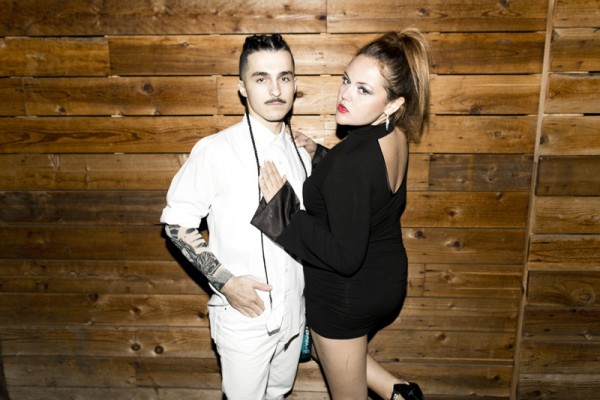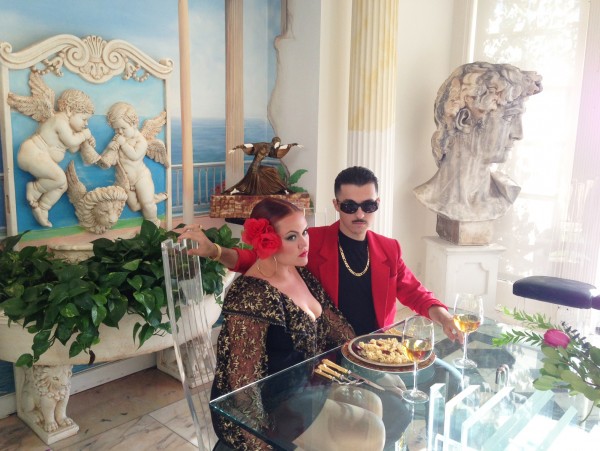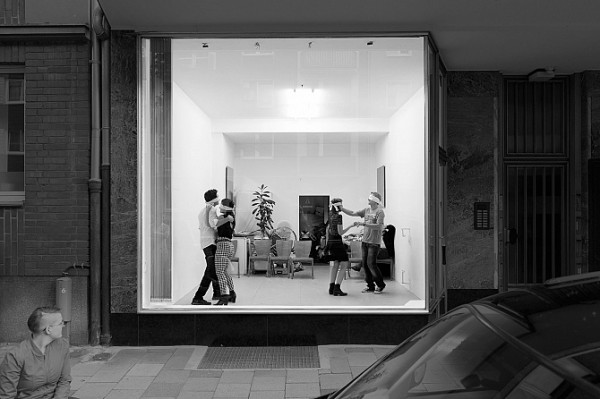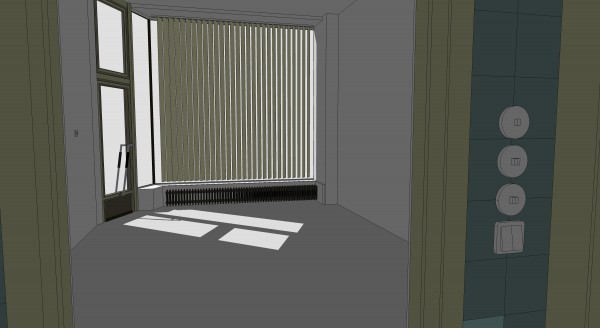The Winners, DIScrit 89plus
Keywords: 89plus, DIScrit, Katerina Llanes, Niko Karamyn, Re Rebaudengo, Riccardo Paratore, Serpentine Gallery, Tierney Finster, Winners
Katerina Llanes interviews the winners of this year’s DIScrit: Niko Karamyan and Tierney Finster, winners of the open public vote, and Riccardo Paratore, winner of the International Jury Vote. Here, the winners discuss their influences behind their projects, as well as issues of connectivity and globalization as related to how they identify themselves within their unique spaces. In addition to the title, the winners also received the €15,000 Re Rebaudengo Serpentine Grant to award their work and honor their emerging talent.
Niko Karamyan (1992) and Tierney Finster (1991)

Congratulations on winning the popular vote! Can you tell us a little bit about yourselves, your influences, and the context for your project?
Niko and I became friends in middle school. We went to a humanities magnet in the San Fernando Valley and were on the same elective track in 7th grade. The class wheel included International Food and Games, Beginning Art, Intro to Computers, and Constitutional Law. We liked playing together, and were always good at creating scenarios and talking through them as ourselves / other characters. As we got cell phones and cameras, taking pictures and filming ourselves became a hobby. For the most part, we’ve both always been comfortable with idea of an audience. We wanted to share our fun and maximize its potential by including others in the process. At the time, we mostly shared ourselves through Myspace and Youtube, but BBM and iChat were also of striking importance to that early teen / barely high school era – especially in talking to one another. Our stream of back and forth thought exchange has gone on for so long that our ability to access each other’s thoughts and effectively communicate has become instinctual.
Our context is oneness. “Can We Talk” and “Drop” reflect moments from our evolution together. The videos explore and celebrate love. Neither of us is afraid of emotional intimacy, if anything we probably crave sharing it. In the third installation, we will discover and represent love’s more painful side – its demise. This is not reflective of our off-screen relationship, but more so a dose of fantastical reality. All things change, all things end, and these characters want to end beautifully.
We also both stay fascinated by strangers and nature. Niko is particularly amazing in the way he connects with the natural world –plants, animals, bodies of water, etc. His celebration of that has been very influential to our lives and work. I think we both shy away from calling what we do work, because regardless of the effort or energy things require, we are doing what would be doing for fun anyway when we are “working.” I feel deeply influenced by basically everything and everyone, humans and our imagined and realized worlds. For me everything usually relates back to words, language and storytelling. Richard Rorty, the novelist Alex Shakar, Dave Chappelle, Kendrick Lamar and decades of other rap lyricists– some of the word players closest to me.
What relationship, both culturally and geographically, do you see between winning the popular vote and being from LA?
We don’t know if being from LA had a lot to do with winning the popular vote, but our instinct is to say no. It’s a big city and growing up here has allowed us to form relationships with a lot of people, so that definitely helps. LA is huge and there is always more to discover here, but it many ways it feels like any other town to us. Culturally, LA has shaped us. LA functions on creative leisure and so do we. While the Internet is to thank for allowing us to form larger and more global networks of friends, collaborators, and voters, attempting to get people to vote had a lot to do with the lifetime of relationships we’ve sustained here. People from schools, jobs, family members, older social networks … these pasts allowed for a lot of our present reality.
You both use digital media to establish hyperreal individual identities (ie Niko the Ikon) yet you also work collaboratively. Can you talk about shifting between these two opposing modalities?
Although we have may have cultivated these “hyperreal” identities through social media, they are very much us. I wouldn’t say anything about who we are or what we do is opposing. We enjoy our individual identities, and there is inherent difference between us, but all of that facilitates our mutual growth personally and creatively. We might be obsessed with the respective languages we broadcast, but it’s not a selfish practice. For being an Ikon, Niko is the least egotistical person I know. We use ourselves, but not just for ourselves.
As artists working on and with the Internet, what kind of freedom (or lack thereof) do you experience by putting your work on the web? How do you see the Internet and the art world evolving in the future?
The Internet allows people to do things for themselves. We live in a context of institutional fault and failure, and by taking things into our own hands we become our own self-startups. “Art” is communication, and online we can communicate freely with whomever chooses to engage with us. “Can We Talk” was filmed over two days on the same VHS camera that recorded Niko’s birth. We were in a Big Bear cabin playing with friends, and were eventually able to share our results on Youtube. There’s freedom to the output, but it’s a freedom we’ve basically always known. Posting these videos wasn’t much different than posting our earliest collaborations. Like anything, the Internet becomes limiting when one is searching for validation within it. We love what we make and ourselves, and don’t share any of it to legitimate. The power and freedom comes from our shared ability to make the private public online. Audiences and feedback only enrich the experience.
In describing the music video “Drop”, you talk about the ways in which you are playing with social media and blurring lines between authenticity and artificiality – self-awareness being key. How important is it to you that this be legible to your net-native audience?
The way people present themselves through image and text online gives us an understanding of who they are and what they represent. In today’s hyper-consumer society, most people are posited as identity shoppers. The Internet’s visual encyclopedia and social media’s creation of personal archives supports our generation’s venture to figure out who we want to be and how we want to live. To different extents we are all consumers, but our work speaks to the individual capabilities we have as creators and products. We are all consuming, but we want everyone to consume better. Young people’s ability to endlessly reference and extract culture online can limit the expression of personal, fresh perspectives. People can watch us do us, but we most appreciate the people who are also seriously doing them. I don’t think humans have any essential nature other than love and connectivity, so it’s hard to determine what really is “artificial.” In taking on roles or personas, we are still discovering as ourselves. We create to be our own living fantasies, so it’s all real. We may think we know who we are and what we do, but we are not bound to fixed definitions of ourselves. We’re 21, that would be boring.

What possibilities and / or limitations do you anticipate for you and your work by being framed within the multiple contexts of DIS, 89plus, and the Serpentine?
We are extremely grateful for the support offered to us by DIS, 89plus, and the Serpentine. There aren’t limitations to this, because the nature of our work isn’t going to shift to in some way cater to the new framework. These relationships offer us enormous possibility. To be embraced as ourselves and provided such generous access and funding is really a dream.
What qualities do you find specific to the generation born after 1989?
Most of us came of age online. Older Internet users tend to separate the “real world” from the Internet. For a lot of people our age, the Internet and its transmitted lives are just as real, or more real, than their physical existences. A key generational element is global, social anarchy. Youth from all different spatial locations, disciplines, and backgrounds come together through Internet platforms. There is greater exposure to diversity, increased fluidity in relationship formation, and an amplified sense of spectatorship of both others and ourselves. As a project, 89plus succeeds in examining our generation without vilifying it. One can argue that the 89plus generation is most passionate about ourselves, but that doesn’t have to be a bad thing. Personal agency and the cultivation of individual power are key characteristics for anyone interested in liberation and revolution. When our generation is able to connect some of these developmental characteristics with the realization of our own spiritualty and consciousness, there is amazing potential for change throughout the world. What’s important here is not escaping personal or societal hardship through Internet usage, but employing the online world as a support system, an information database, and a worldwide community. The Internet moves a lot quicker than the speed traditional institutions function at, but it doesn’t need to do so only in relation to capital and coolness. If young people recognize the ability for self-creation and improvement through their Internet practices, we hope that this sense of empowerment can be injected into their day-to-day lives. We hope to live in a world, or at least in communities, vibrating in love, and the ability to love others is impossible without working on one’s love of self .
How do you plan on using this opportunity / the Re Rebaudengo Serpentine Grant?
We are using our Re Rebaudengo Serpentine Grant to create a concluding video for our series. The award will finance our use of new technology and more complex production methods for this installment.
Riccardo Paratore (1990)
Congratulations on winning the jury vote! Can you tell us a little bit about yourself, your influences, and the context for your project?
Thanks a lot! I’m very happy to receive the prize! I was born in 1990. I’ve been studying at the Duesseldorf Art Academy. One year ago, I moved to an abandoned shop. At first, I was just intrigued by the idea of living in that office space with a huge front window and had not yet made a concept out of it. Then I started inviting other artists to the space and so the project evolved – more so from intuition than actually planning it.
What relationship, both culturally and geographically, do you see between winning the jury vote and being from the EU?
I was surprised, since I do not represent the often-cited new, up-and-coming art worlds in Asia. For me it shows that the Western art world still has a strong impact in the global art field.
The durational aspect of your work seems to reflect on the increased speed at which global networks operate today – in particular the speed of virtual communication. Your work very much focuses on physical interaction and intimacy in real time. In what way is this a response to digital vs. corporeal connectivity?
It certainly relates to this opposition of digital vs. physical that you’re describing. The performative events I organize always include real-time – sometimes they take up to 72 hours. The events have been accessible only to a physical–and thereby local–public. The context of globalized virtual networks is an important backdrop that creates a certain tension in here. The setting of perception cannot be regulated, adapted or modified by the individual (audience) but is given in time and space, so to say, and is not influenceable.
What kind of freedom (or lack there of) do you experience by putting your work on the web? How do you see the Internet and the art world evolving in the future?
A friend of mine has just built a 3D model of my space that can also function virtually. From my point of view, that’s an interesting way of thinking about display and how to overcome this specific physical distance between the public and the work that you always have to deal with in exhibitions and performances. For myself, there is still this gap – or maybe even opposition – between a physical and a virtual reality.
What possibilities and / or limitations do you anticipate for you and your work by being framed within the multiple contexts of DIS, 89plus, and the Serpentine?
I am really curious as to how it will evolve. I think that it’s particularly interesting since my work engages with different modes of display, which allows me to develop the questions of display and real-time performance events further and in new challenging contexts.
What qualities do you find specific to the generation born after 1989?
I don’t know if it’s possible to talk about ‘the generation’ in general. Although the majority of us are linked to each other virtually, there are still many differences ‘in reality’.
How do you plan on using this opportunity / the Re Rebaudengo Serpentine Grant?
I will start working on new projects. I have just moved to Frankfurt and will do some more research in order to realise more projects that exist only virtually so far.

